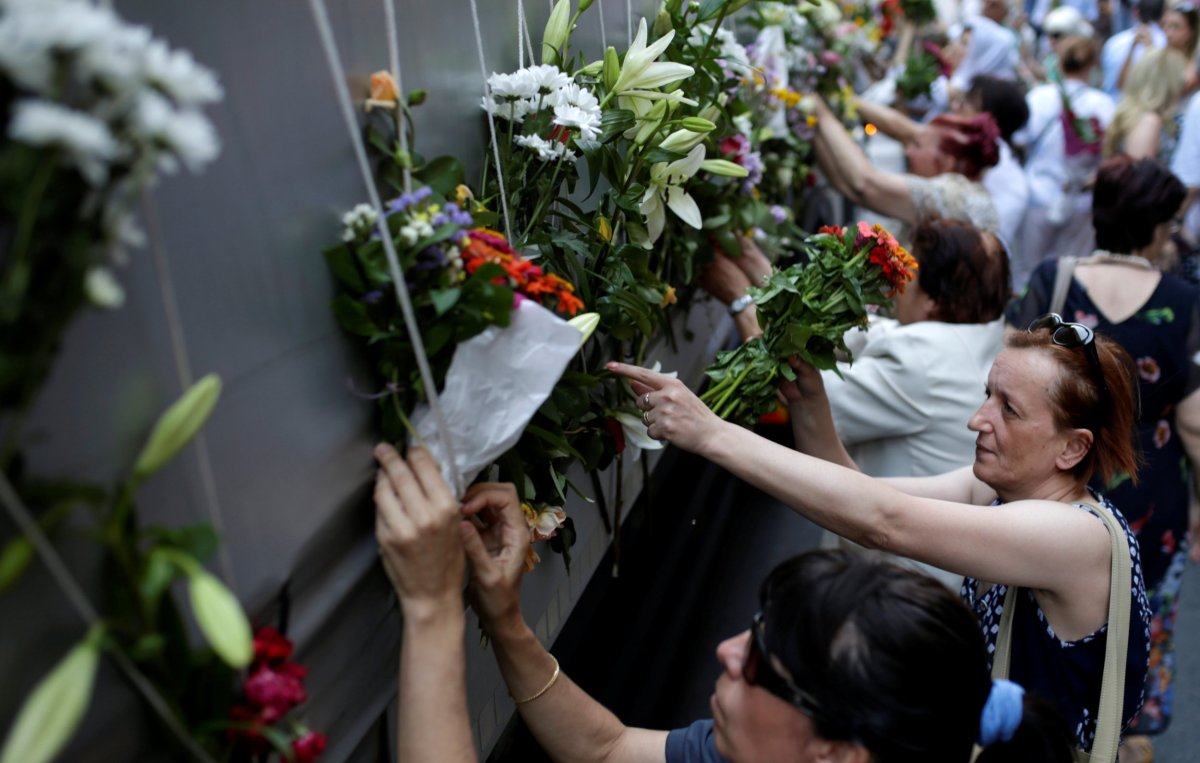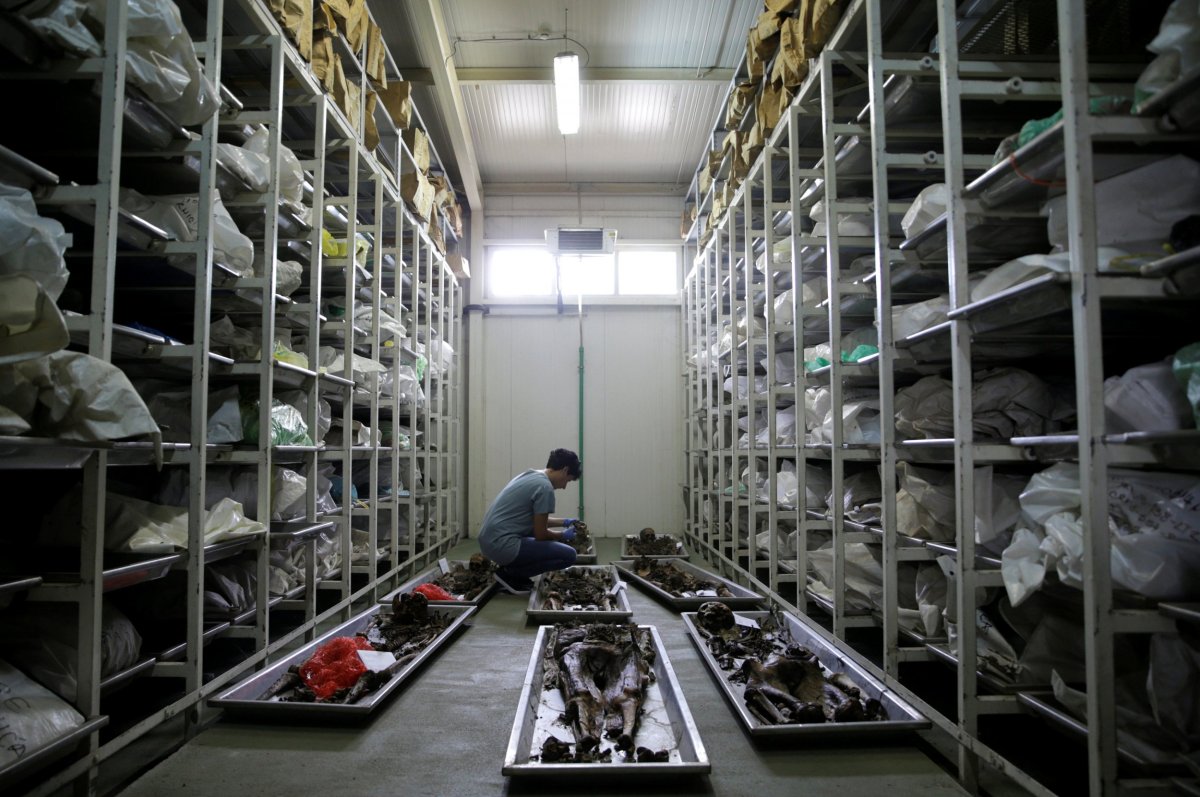
It seems to have become an annual ritual: A truck carrying coffins is driven through Sarajevo, the capital of Bosnia and Herzegovina, as thousands of Bosnians look on, weeping, praying or placing flowers on the truck as it passes. Last year, the truck carried 136 victims of the July 1995 Srebrenica massacre whose remains had lately been found in mass graves and identified with DNA analysis; on Saturday, the remains of another 127 newly found victims made the journey.

As is the case each year, Saturday's solemn event closely preceded the anniversary of the massacre, in which roughly 8,000 Muslim men and boys were killed. Tens of thousands of people gathered Monday to mark 21 years since the event, which the International Criminal Tribunal for the Former Yugoslavia (ICTY) and the International Court of Justice have deemed genocide. It is often called the worst mass murder in Europe since the Holocaust half a century earlier.
"After all these years, his body was found," Fatima Duric told the Associated Press of her late husband. "In fact, just a few bones. I am burying them today."
The U.N. Security Council designated Srebrenica a "safe area" in 1993, amid the war in Bosnia. As Newsweek pointed out earlier, the council wrote in Resolution 819 that it "demands that all parties and others concerned treat Srebrenica and its surroundings as a safe area which should be free from any armed attack or any other hostile act" and that it "condemns and rejects the deliberate actions of the Bosnian Serb party to force the evacuation of the civilian population from Srebrenica and its surrounding areas as well as from other parts of the Republic of Bosnia and Herzegovina as part of its overall abhorrent campaign of 'ethnic cleansing.'"
The resolution requested that then-Secretary General Boutros Boutros-Ghali "take immediate steps to increase the presence of UNPROFOR [United Nations Protection Force] in Srebrenica and its surroundings" and demanded that "all parties guarantee the safety and full freedom of movement of UNPROFOR."
But the resolution didn't prevent Serb troops from advancing on Srebrenica more than two years later, on July 11, 1995, and overrunning U.N. observation posts. Many of the local civilians fled to the U.N. base in nearby Potocari, hoping that the Dutch peacekeepers would protect them. But the peacekeepers were outnumbered. In the days that followed, men and boys were separated from the crowd and taken to be executed, while women and children were sent via buses to Bosnian-held territory, where they ended up at a displaced persons camp in Tuzla. Another group of men had begun walking through the forests toward Bosnian-held territory, and many of them were killed after encountering Serb troops.
The ICTY estimates that within a week after the fall of Srebrenica, Bosnian Serbs had murdered between 7,000 and 8,000 Muslim men and boys. They buried the dead near the mass killing sites, but later reburied the remains at dozens of other sites in an attempt to cover up their crimes. The reburial process—during which bodies were broken up and body parts mixed in new graves, sometimes miles apart—made it more difficult to identify the victims by traditional means, such as skeletal anthropology or dental records. Every year additional victims are identified through DNA analysis and buried at the memorial center in Potocari. The 127 newly identified victims whose coffins passed through Sarajevo on Saturday joined 6,337 others.

This year's anniversary comes roughly four months after the ICTY convicted Radovan Karadzic, the former leader of the Serb republic in Bosnia, of 10 counts of war crimes, including genocide in Srebrenica. The court sentenced him to 40 years in prison. Karadzic is one of six the tribunal has convicted for involvement in the Srebrenica genocide.
Still, there is adamant opposition in some quarters to the use of the term "genocide" to describe the events that followed the fall of Srebrenica. Ahead of last year's 20th anniversary, Russia vetoed a U.N. Security Council resolution that would have condemned the massacre as genocide. At the ceremony, a crowd booed and chased away Serbian Prime Minister Aleksandar Vucic, whose government acknowledges that crimes took place but avoids the word "genocide."

This year, victims' families demanded that anyone who disputes the genocide stay away from the anniversary event. Milorad Dodik, president of the Serb Republic in Bosnia, said in response, "That was not genocide and Serbs will never accept that word."
Carmel Agius, president of the ICTY, spoke strongly to the contrary at Monday's event. "I stand before you proud that the ICTY has incontrovertibly established that genocide did occur here, in Srebrenica, in July 1995, and that it has prosecuted and convicted a number of key figures responsible for it," he said.
"A fundamental part of any reconciliation process is justice, [but] justice alone is not enough," he added. "Only by fully acknowledging the past can we achieve a future of true and lasting reconciliation."
Uncommon Knowledge
Newsweek is committed to challenging conventional wisdom and finding connections in the search for common ground.
Newsweek is committed to challenging conventional wisdom and finding connections in the search for common ground.
About the writer
Stav is a general assignment staff writer for Newsweek. She received the Newswomen's Club of New York's 2016 Martha Coman Front ... Read more
To read how Newsweek uses AI as a newsroom tool, Click here.








